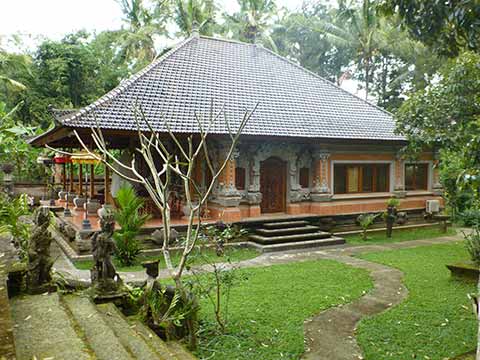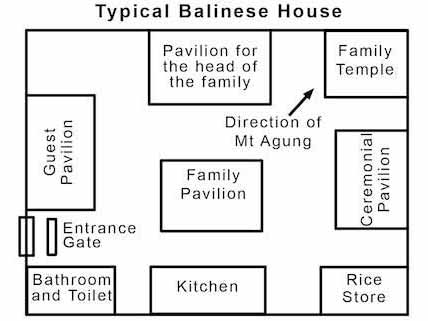Balinese Architecture & Building Design
Balinese Building Layout and Spiritual Considerations
The design of buildings and the layout of villages and housing compounds are very important in Bali, the Balinese take this very seriously and insist that buildings cannot get an IMB (building permit) if they do not contain elements of Balinese design.
The spirits must always be considered and must conform with the concept of Tri Angga.
Here we look at the importance of building design and the requirements for a building permit, or IMB. We look at the separation of the realm of the heavenly spirits, the earthly realm where people dwell and the underworld where the mischievous (or evil) spirits dwell.
We also look at how these are considered and defined in the layout of house and temple compounds and in village layout.
See also:
- Balinese Architecture and Building Design Part 2 - Principles of Building Design
- Balinese Architecture and Building Design Part 3 - Structures, Materials and Decoration

Part 1 - Balinese Layout and Spiritual Background
Balinese traditional culture is one of the most amazing cultures in the world. It is the very essence of this island and the magical ingredient that attracts visitors from all over the world. We all appreciate the richness and depth of this culture with its spectacular presentation but, perhaps less obvious, is the fact that this is one of the very few places in the world that still retains its traditional identity with its spirituality, costume, music, dance, folklore, belief systems, social structure, administrative arrangements, security arrangements, cuisine, ceremonies, rituals and probably even personal habits all interwoven into a thriving single, integrated whole. We Brits, Americans, Canadians, Aussies and Kiwis lost ours two thousand years ago when Christianity swept away our Pagan origins and supposedly made us "civilised".
Balinese requirements for a building permit or IMB
Probably the most visible aspect of Bali's cultural treasure trove is its architecture. The elders of Bali are constantly considering how their culture can be preserved and protected and to this end have built a series of rules into legislation. Before anyone builds they must have a building permit (an IMB or Ijin Mendirikan Bangunan) and an IMB will not be issued unless certain conditions are satisfied.
Among these requirements are:
- An IMB is obtained before construction starts.
- The land is zoned for the function of the building being proposed.
- The land is zoned to permit the density of buildings being proposed.
- Immediate neighbours have signed documents that state that they agree to the building being proposed.
- Buildings are no higher than a palm tree (considered to be 15 metres high).
- The building is properly designed with a structure that will withstand earthquakes.
- The building incorporates elements of Balinese architectural style within its design.
With a bit of common sense it can be seen that these requirements are well thought out and provide the opportunity to protect the interests of Bali, the interests of the person building the building and the people that live around the building.
Unfortunately as time passes these requirements are increasingly being ignored and, make no mistake, we all suffer in the long run. Not least the future of Bali is put in jeopardy. It is, after all, the unique quality of Bali that makes it stand out from the crowd. Put simply the touist interest has to b satisfied if Bali is to survive and thrive as a tourist destination with its own identity.
In Bali all buildings must contain elements of traditional Balinese architectural design
You will note that one of these rules require that buildings "incorporate elements of Balinese architectural style in their design". Many of us have heard of this rule but what exactly does it mean? Even architects appear to be confused and many modern buildings include what can only be described as some "token gesture" to get their IMB application passed.
This token gesture usually comes in the form a pitched roof with decorations on it and, while such a roof might appear in the drawings submitted with the IMB application, all too often it mysteriously doesn't find its way onto the completed building.
We all know that many places in the world (Switzerland, Austria, Spain, Britain immediately spring to mind) have areas where there are strictly enforced design criteria to ensure that new buildings fit into their surroundings and retain the picture postcard beauty that gruntles the grockles and keeps their tourism industries afloat. The Austrians and Germans would never allow picturesque views of chalets and castles to be destroyed by some onanist who decides to build a flat roofed, minimalist monstrosity next door.
For those of us who love Bali and appreciate its rich traditional culture the importance of constructing buildings that fit into the landscape is obvious and any architect worth his salt would fully understand this and would actively support the intention.
So let us look a Balinese architecture and see if we can shed some light on what we might do to incorporate or add elements of Balinese architectural style in our buildings.
Balinese architecture is deeply influenced by its Hindu spirituality
Let me say at the outset that Balinese architecture is complex and mystical. It is, as with all elements of Balinese culture, deeply integrated with its spirituality and belief systems. Rules are determined to satisfy religious requirements and the constant need to maintain harmony and balance. These rules have important considerations for the karma of all the people involved particularly the property owner. These religious considerations are very important for the Balinese and the starting point for virtually everything they do.
The Balinese believe in the concept of Tri Angga and consider a world in which everything is divided into a hierarchy of three distinct parts.
- The higher pure places or Utama where the gods dwell.
- The middle neutral places or Madya where we mere mortals dwell.
- The lower places or Nista where evil and mischievous spirits dwell.
For the Balinese it is important to continually maintain harmony and balance between the higher and lower places or there will be problems. In their search for harmony Balinese builders work closely under the guidance of priests who may consult sacred documents in the placement, orientation and design of their buildings.
It is all far too complex for us to understand however, keeping it simple, there are four ways we can incorporate Balinese architecture in our buildings:
- Place and orient buildings respecting the concept of Tri Angga.
- Design the buildings respecting the concept of Tri Angga and reflecting the types, shapes and sense of proportion used in Balinese structures.
- Use traditional materials.
- Incorporate Balinese decoration in our buildings.
Village planning, building placement and orientation.
In Bali Tri Angga is a very important consideration in town planning and land zoning, the placement of buildings and facilities must reflect their function and where this function sits in terms of purity. I don't know if you have noticed but Bali is a sloping sort of a place. It seems that everywhere you go there is an uphill towards the mountains and a downhill towards the sea. The higher places or Utama are the mountains particularly Mount Agung where the gods dwell while the sea is Nista or lower, impure places where sea monsters and demons dwell. The people live in the Madya or middle neutral ground on the coastal plains and the lower slopes of the mountains.
Balinese placement and orientation constantly refers to four directions:
- Towards the mountains, the home of the gods, known as Kaja.
- Towards the sea, Home to sea monsters and demons, known as Kelod
- Towards the rising sun known as Kangin
- Towards the setting sun known as Kauh
Balinese villages are laid out in accordance with these directions. A temple to the gods, the Pure Puseh, is placed at the uphill Kaja end of the village. A temple to the earthly spirits, the Pura Dalem, is placed, along with the graveyard (which is considered a dirty place) at the lower Kelod end of the village. The people live between the two and in the centre of the village you will find the Pura Desa and public buildings.
Traditional Balinese house layout
The principle is also applied in house layout. A traditional Balinese house is not a single building but a collection of buildings within a family compound. All the buildings in the family compound are placed according to their function and how they fit into Tri Angga as follows:

The Kaja - Kangin corner of this compound which is nearest to Mt Agung is where the family temple to the gods (or Sanggah) is built. The vast majority of people in Bali live to the South West of Mount Agung and so you will find the family temples are built in the North Eastern corner of their house compound. In Singara you will find the family temples are built in the South Eastern corner.
Next to the family temple on the uphill, Kaja side of the compound is built the sleeping quarters for the head of the household (or Umah Meten). This is built, as are all the buildings, with the entrance facing towards the centre of the compound.
In the middle of the Eastern, Kangin side of the compound you will find the ceremonial pavilion used for tooth filings, weddings and the like.
In the middle of the Western, Kauh side of the compound is the guest pavilion.
In the middle of the downhill, Kelod side of the compound is the kitchen (or Paon).
The toilets and septic tanks are considered dirty and are situated at the Kelod corner of the compound in the opposite corner to the temples.
The entrance gate is usually placed on the Kauh side of the compound at the lower Kelod end. This is because the entrance is a place that demons may try to enter. We will talk more about Balinese gates another time.
Note that direction is very important and if you ask a Balinese for directions you'd better have a compass. They won't tell you to turn right, then left, left again and then straight on, they will say something like turn North, then West, then South and keep going South. At all times they are fully aware of direction which relates back to the geographical representation of Tri Angga.
The Tri Angga is also applied in the design of buildings and the order in which they are constructed and we will look at this next issue.
It is interesting to note that Tri Angga is also applied to our bodies. Our head is Utama, our body is Madya and our feet are Nista and so it is important that people always sleep with their heads towards the Mountains (Kaja) and feet towards the sea (Kelod) which, for most of us, means we sleep with our head to the North or East.
Next time you are talking to a hotel manager perhaps you could just point out whether his/her beds are oriented in the correct direction, I am sure he will be very grateful for the information.
See also:
- Balinese Architecture and Building Design Part 2 - Principles of Building Design
- Balinese Architecture and Building Design Part 3 - Structures, Materials and Decoration
Phil Wilson
Copyright © Phil Wilson August 2014
This article, or any part of it, cannot be copied or reproduced without permission from the copyright owner.
